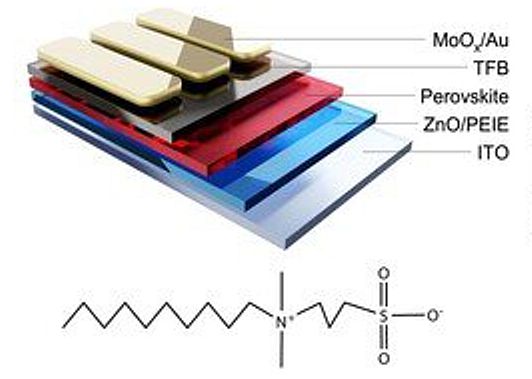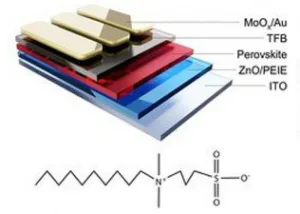Up to now, poor device stability has hampered commercialization of display products using perovskite-based LEDs. To put the extent of the stability problem into perspective, at this time, the typical lifespan of perovskite-based LEDs is on the order of 10 to 100 hours as compared to 10,000 hours for conventional OLEDs.

The issue of stability in perovskite-based LEDs has been the subject of research by a team led by Bingbing Guo of the State Key Laboratory of Modern Optical Instrumentation, College of Optical Science and Engineering; International Research Center for Advanced Photonics, Zhejiang University (Hangzhou, China).
A recent article by the team on this topic is entitled “Ultrastable near-infrared perovskite light-emitting diodes.” The article was published in Nature Photonics 2022. A copy of the article is available for purchase and can be found here. It should be noted that the research reported in this article relates to near infrared (~800?nm) light emitting devices but that the team feels the approach could also be applied to devices that emit visible light.
In their article, the researchers explain that part of the reason for the short lifetime in some perovskite-based LEDs is due to an intrinsic instability attributable to the ionic nature of the material’s crystal structures. In other words, the ions are able to move around when a voltage is applied to the LED and this, in turn, can lead to material degradation.
To address this issue, the team adopted an approach based on the use of a dipolar molecular stabilizer. A simplified explanation of the stabilization mechanism is that the dipolar molecules chemically bond or interact with all positive and negative ions at the perovskite crystal grain boundaries. This, in turn, reduces ion migration under the influence of an electric field and stabilizes the perovskite.
The figure below illustrates the configuration of a perovskite-based LED. Also included is a diagram indicating the structure of a particular dipolar molecular stabilizer.
 Configuration of the perovskite-based LED (top of figure). Structure of the dipolar molecular stabilizer material called SFB10 (bottom of figure).
Configuration of the perovskite-based LED (top of figure). Structure of the dipolar molecular stabilizer material called SFB10 (bottom of figure).
Electrical and optical tests were conducted and measurements performed on prototype devices to determine device stability. The researchers expected that lifetimes were likely to extend over many thousands of hours. Due to this, and in order to obtain the lifetime data within a reasonable timeframe, accelerated aging tests were used – as is common procedure in LED lifetime testing.
A top level result of the team’s research was the finding that the use of a dipolar molecular stabilizer could “help perovskite retain its original, optoelectronically active crystal phase over an extended lifetime.” Some interesting results drawn from the article are as follows.
The crystal structures did not change for more than 322 days while untreated perovskite samples changed their crystal structures and decomposed in about two weeks. In other tests, stabilized perovskite LEDs showed no performance degradation over 3,600 hours of continuous operation under a current of 5 mA/cm2. The estimated T50 lifetime (time required for the initial radiance to drop to 50%) was 32,675 hours at an initial radiance of 3.2 mA/cm2. This radiance is about the same optical power for a commercial green OLED working at a high brightness of 1,000 cd/m2. At a low initial radiance of 0.7 mA/cm2 the forecasted T50 lifetime would be 2.4 million hours.
The researchers go on to report device peak external quantum efficiency of 22.8% and energy conversion efficiency of 20.7%. These are represented as the highest efficiency values ever obtained for a near infrared perovskite-based LED.
The researchers conclude their article with the observations that
“These results remove the critical concern that halide perovskite devices may be intrinsically unstable. The ultralong lifespans are expected to boost confidence in the field of perovskite LEDs, as they now satisfy the stability requirement for commercial OLEDs. While further efforts are needed in developing visible devices with similar longevity for full color displays, the demonstration of ultrastable perovskite LEDs has paved the path toward industrial applications.”
-Arthur Berman
Zheiang University, Dawei Di [email protected]

